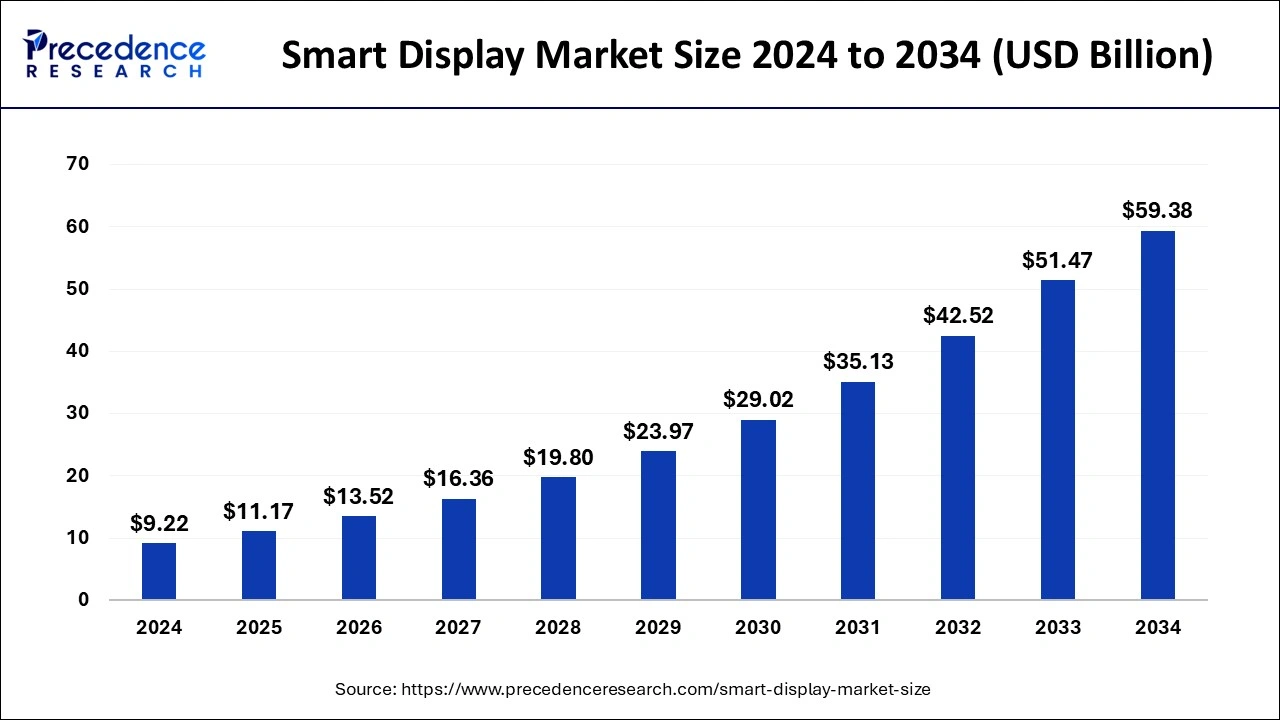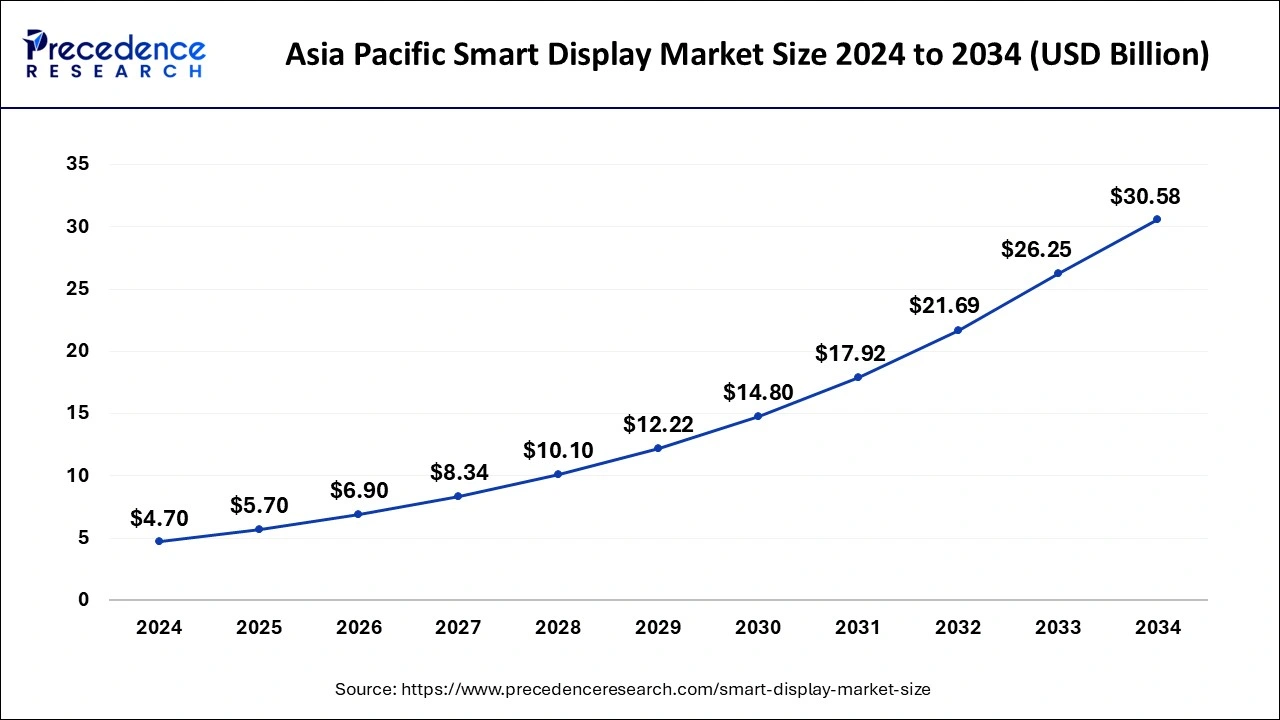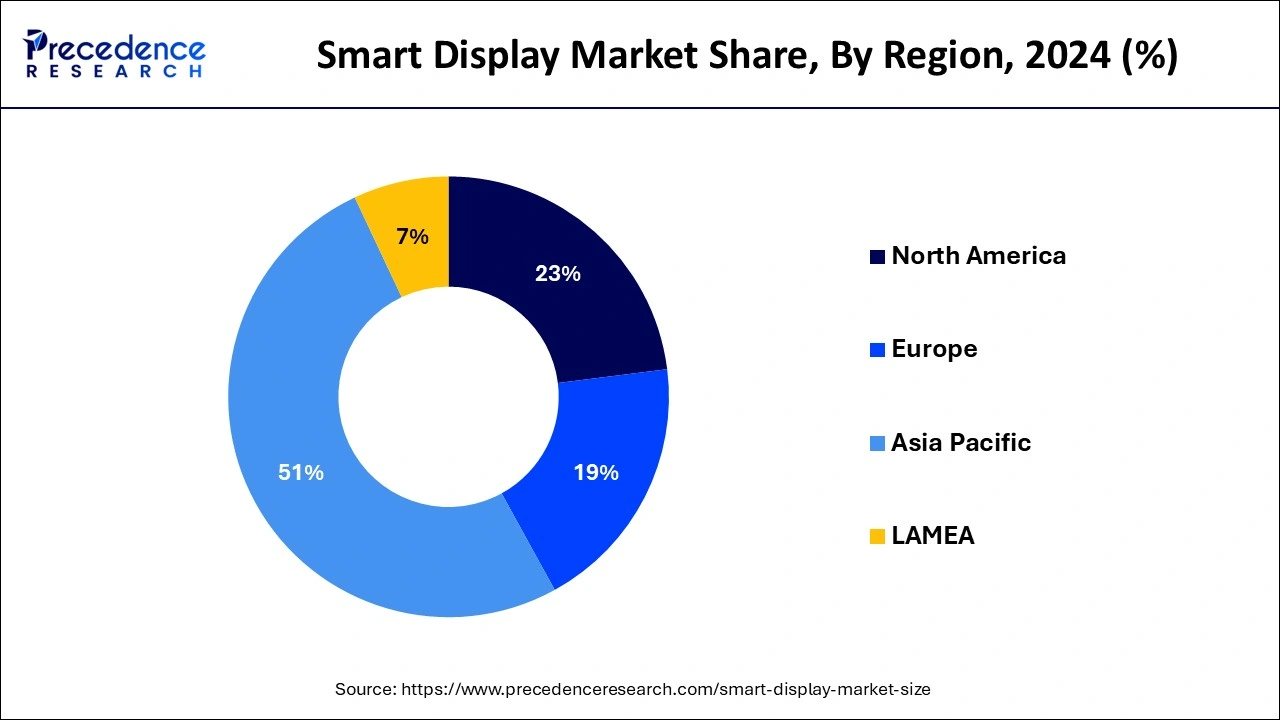List of Contents
Smart Display Market Size and Forecast 2025 to 2034
The global smart display market size accounted for USD 9.22 billion in 2024 and is predicted to increase from USD 11.17 billion in 2025 to approximately USD 59.38 billion by 2034, expanding at a CAGR of 20.47% from 2025 to 2034. The increasing penetration of smart devices and internet users is driving the growth of the market.

Smart Display Market Key Takeaways
- The global smart display market was valued at USD 9.22 billion in 2024.
- It is projected to reach USD 59.38 billion by 2034.
- The market is expected to grow at a CAGR of 20.47% from 2025 to 2034.
- Asia Pacific led the smart display market with the largest market share in 2024.
- North America is expected to witness the fastest growth in the market during the forecast period.
- By technology, the LED display segment dominated the market with the largest market share in 2024.
- By type, the smart home display segment held the largest share of the market in 2024.
- By end users, the retail segment led the smart display market in 2024.
Asia PacificSmart Display Market Size and Growth 2025 to 2034
The Asia Pacific smart display market size was evaluated at USD 4.70 billion in 2024 and is projected to be worth around USD 30.58 billion by 2034, growing at a CAGR of 20.60% from 2025 to 2034.

Asia Pacific led the smart display market with the largest market share in 2024. The region is observed to sustain the position throughout the forecast period. The growth of the market is attributed to the rising adoption of smart devices along with the rapid expansion of manufacturing industries in countries like China, India and Japan. Along with this, the increasing adoption of smart technologies in different commercial and domestic applications are driving the growth of the smart display market. The rising economic development and the urbanization in the regional countries and the rising demand for smart home gadgets, smart consumer gadgets like smartphone, laptops, tablets, etc.
The increasing demand for smart displays from the retail and automotive industry is further propelling the expansion of the smart display market in the region. Additionally, the rising emphasis on smart buildings and increasing number of smart schools, malls and other areas that promote the utilization of smart and advanced solutions create a significant potential for the market to sustain its position in the region.

North America is expected to witness the fastest growth in the smart display market during the forecast period. The growth of the market in the region is the rapid adoption of the smart technologies and the rising implementation of the smart displays in the various application like in sport stadium, billboards, retail industry, and others that are accelerating the growth of the market. The rising public and private investment in research and development activities in the development of advanced technologies are contributing in the growth of the smart display market across the region.
- There are 53.9% homes in the United States that are automated with the smart home industry in 2024.
Market Overview
While offering an advanced level in smart devices category, the smart display market revolves around the development, innovation and distribution of computing LCD or LED screen that controls multiple activities while being integrated with a Wi-Fi system. Smart displays are added with touch screens and smart speakers. Smart displays have the ability to connect with the smart home application and automated as per the command for the users.
The increasing demand for the smart displays for various industrial application such as demand for the smart mirrors from the automotive industry, and smart displays from the consumer electronics or gadgets such as smartphones, laptops, tablets, etc. Is promoting innovation in the industry across the globe. Along with this, the increasing usage of internet and smart devices with the integration of AI and IoT technologies are driving the growth of the smart display market.
Smart Display Market Growth Factors
- The rising demand for smart home technologies and automation is driving the growth of smart displays market.
- Multiple technological advancements in smart devices like smart speakers, CCTV monitors, and the heavy demand for touchscreen mobile phones, television, and laptops are contributing to the growth of the market.
- Improving living standards, especially in developed areas due to the increased disposable incomes along with that rising urbanization creates a significant potential for the market to grow.
- The increasing demand for smart screen gadgets like laptops, tablets, smart phones, home appliances, and other advanced domestic and commercial gadgets are accelerating the growth of the smart display market.
- Substantial growth in new product launch across the globe along with rising research and development activities is observed to promote the market's growth.
Market Scope
| Report Coverage | Details |
| Growth Rate from 2025 to 2034 | CAGR of 20.47% |
| Market Size in 2025 | USD 11.17 Billion |
| Market Size in 2024 | USD 9.22 Billion |
| Market Size by 2034 | USD 59.38 Billion |
| Largest Market | Asia Pacific |
| Base Year | 2024 |
| Forecast Period | 2025 to 2034 |
| Segments Covered | Technology, Type, and End-Users |
| Regions Covered | North America, Europe, Asia-Pacific, Latin America, and Middle East & Africa |
Market Dynamics
Driver
Integration of AI in smart devices
The integration of artificial intelligence and Internet of Things (IoT) in the smart devices is enhancing the technologies and the growth in the sales of the smart devices. AI and IoT enhance the performance and applications in artificial intelligence. Integration of AI into the devices generates an intelligent system in the devices that acts like humans. For example, ChatGPT, Alexa, and other chatbots have created substantial potential for smart devices in the market.
Artificial intelligence analyzes and interprets data that provides useful insights that enhance efficiency and productivity. The implementation of the AI in the home automation or the smart home devices, automobiles, manufacturing industries, smart phones, tablets, PCs, laptops, smartwatches and other digital products which increases the efficiency, and the quality of the smart devices are contributing to the overall expansion of the smart display market.
Restraint
High cost
The manufacturing cost of the single smart screen display is higher than the conventional type of screen manufacturing. Technologies such as NLP-based parts, voice assistance speakers, voice sensor, and processor installed with the smart displays make it higher in cost. Additionally, smart displays need to be integrated with various systems which require additional settings along with advanced technologies. Therefore, the cost factor is observed to create a restraint for the smart display market. Smart display technology is still newer to the industry which creates skepticism among consumers which hampers the market expansion.
Opportunity
Trends and advancements in the smart displays
The ongoing research and development activities in the advancements in smart displays are observed to create a significant opportunity for the growth of the smart display market. Flexible display, immersive displays, digital signage, micro-LEDs, LCDs, advanced projection technologies, OLEDs, quantum dots, and laser display technology are some of the technological trends in smart displays.
Flexible displays are thin, lightweight, and specialized form factors that enhance the growth of flexible displays. It is used in automotive head-up displays (HUDs), wearable, and smartphones. Immersive displays can provide interactive augmented realities (AR) for the users with the head-mounted displays (HMDs). Digital signage uses technologies like LED, LCD, projection, and e-paper.
Technology Insights
The LED display segment dominated the smart display market with the largest share in 2023. The increasing adoption of LED screens and the wider range of applications are driving the expansion of the LED segment. LED is the composition of the LED dots electronic display screen. LED is gaining popularity owing to its efficient properties such as compact size, extended lifecycle, reduced energy consumption, and flexibility in use and applications. LED displays are found in different forms including stadium screens, large outdoor digital billboards, indoor video walls, smaller LED panels that are used for the displaying signage or information.
Due to the presence of precise brightness levels, LED screens are observed to be ideal for outdoor and indoor applications. The wider application and adoption of LED screens in smart home applications is one of the significant factors for the segment's expansion. LEDs have a lower energy consumption rate compared to traditional displays like CRT or fluorescent displays. LED smart displays are observe to have longer lifespan which makes it easy to adopt by consumers and end-users especially in sports stadiums, advertising billboards, retail displays, transportation signage, scoreboards, command centers, and others.
Type Insights
The smart home display segment dominated the smart display market in 2023. The increasing evolution in smart home technologies and the rising urbanization and shift in the lifestyle that accelerating the growth of the smart home displays. Smart home displays are used in managing all the smart home gadgets with a single touch screen. Improving economies, urbanization and emergence of smart cities are driving the expansion of the segment. Major technology giants like Amazon and Google are heavily investing in the development of smart home gadgets and investing in the research on the development of smart technologies that are driving the growth of the smart home displays segment.
End-Users Insights
The retail segment led the smart display market in 2023. The segment is observed to grow at a notable rate during the forecast period. The rapid evolution of the retail industry is driving the adoption of technologies for enhancing the services, productivity, and operations of the retail sector. Technology plays an important role in the expansion and advancement of the segment. Adoption of smart retail displays in the retail industries enhance shopping experience by offering interactive and engaging features.
Smart displays help the consumer to make purchase decisions. The adoption of smart displays in retail industry is observed to increase sales. Smart displays are integrated with technologies like artificial intelligence and machine learning for showing personalized recommendations, advertisement, offers, and information based on the consumer preference. Smart displays use data analytics to provide insights of the consumer behavior to the retailers, these help in optimizing product pricing, placement, strategies, and marketing campaigns.
The healthcare segment is observed to grow at a notable rate during the forecast period. Smart displays improve communication among healthcare teams by providing a centralized platform for sharing patient information, test results, and treatment plans. They enable seamless communication between doctors, nurses, specialists, and other healthcare professionals, leading to more efficient and coordinated care. Smart displays enable remote monitoring of patients and facilitate telemedicine consultations. Healthcare providers can use smart displays to conduct virtual appointments, monitor patients' health status remotely, and provide real-time guidance and support.
Recent Development
- In May 2024, Yale, a leading player in the smart home solutions and division of ASSA ABLOY unveiled Yale Smart Outdoor Camera, Yale Smart Indoor Camera, and Yale Smart Video Doorbell at the Smart Home Expo 2024 in Mumbai's Jio Convention Centre. The devices are designed to enhance the home security system with intelligent features offering easy control and compatibility with other devices of Yale.
- In May 2024, Smart Node, a leading home automation brand introduced the range of smart home products includes KNX DALI Gateway with Wi-Fi, HomeLink Screen Panel central control unit, Wi-Fi DALI Gateway, Curtain Motor, KNX Phase Cut Dimmer, customizable Keypads, and KNX Analog Dimmer.
- In May 2024, VueReal, a Canadian Microsolid pioneer company launched the ColourFusion microDisplay, an augmented reality display that can be used in the automotive, consumer electronics, medical, aerospace, and industrial applications.
- In May 2024, Boult, a rapidly expanding wearable technology brand is expanding its array into the smart home audio segment with the launch of BassBox SoundBars and Space Transforming SoundBar.
- In April 2024, VueReal is introducing its MicroSolid Printing platform and demonstrate its versatility in mass adaptation of MicroLED display and other micro-semiconductor devices with the portfolio of products including AR/VR solutions, and smartphone displays.
B2B Payments Transaction Market Companies
- Samsung Electronics
- Alphabet (Google)
- LG Electronics
- NEC Corporation
- Panasonic Corporation
- Leyard Optoelectronic (Planar)
- Sony
- Magna International
Segments Covered in the Report
By Technology
- LEDs
- LCDs
By Type
- Smart Display Mirror
- Smart Home Display
- Smart Signage
By End-Users
- Retail
- Automotive
- Smart city
- Sports & Entertainment
- Healthcare
- Others
By Geography
- North America
- Asia Pacific
- Europe
- Latin America
- Middle East & Africa
For inquiries regarding discounts, bulk purchases, or customization requests, please contact us at sales@precedenceresearch.com
Frequently Asked Questions
Ask For Sample
No cookie-cutter, only authentic analysis – take the 1st step to become a Precedence Research client